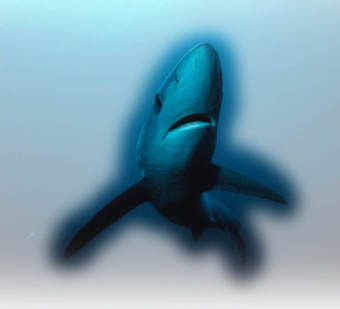
![]()
Volume 7, No. 2
Promoting Cooperation to Maintain and Enhance
Environmental Quality in the Gulf of Maine
|
||||||||||
|
Regular columns |
|
|
|||||||
|
|
|
|
Browse the archive |
|
|
|
|
The truth about sharks:
As understanding about some species grows, so too do concerns about their future
By Andi Rierden, Editor
 |
| A large oceanic species, thousands of blue sharks are caught each year by recreational fishermen and in fishing tournaments. Photo: Greg Skomal |
In the face of slow reproduction, scientists say, these animals are simply unequipped by evolution to withstand such abrupt exploitation.
Precisely how many sharks are killed each year and how many are left is the subject of intense debate. With limited resources for shark research, documentation of life history characteristics and population trends exist for only a handful of the 360 known species.
According to one estimate by the United Nations Food and Agriculture Organization, over the past 50 years the worldwide catch of all elasmobranchs-sharks, skates and rays-has quadrupled, from 200,000 metric tons a year to 800,000. Because a large percentage of sharks are caught unintentionally in longlines and gillnets and go unreported, some researcher estimate that about 100 million sharks are killed by humans annually.
Earlier this year, a study by researchers at Dalhousie University in Halifax, Nova Scotia, published in the journal Science brought world-wide attention to the severity of the overfishing of sharks and provided the first detailed overview of an oceanwide decline with major implications.
"We estimate that all recorded shark species with the exception of makos have declined by more than 50 percent in the past eight to fifteen years," the researchers wrote. The area studied included coastal and deep waters from Newfoundland to northern Brazil. The researchers found that hammerhead sharks had declined by 89 percent in the Atlantic, threshers by about 80 percent and great white sharks by 79 percent.
...more...
From fish farms to wind farms, oil and gas drilling and more:
The growing demands on ocean waters incite the call for zoning
By Maureen Kelly
 |
| Bill Causey, the superintendent of the Florida Keys National Marine Sanctuary |
"It was one of the longest days of my life," says Causey, the superintendent of the Florida Keys National Marine Sanctuary (FKNMS).
Causey and his staff were in the midst of devising a comprehensive marine zoning plan to protect the resources and biodiversity of the 2,800 square mile [7,280 square kilometer] sanctuary, which contains the United States' only living barrier coral reef and thousands of acres of seagrass. The hostilities arose when certain members of the public learned that the plan designated no-take zones and restricted their activities in sections of the sanctuary. No-take zones, just one type of ocean zoning, are areas of the ocean where potentially harmful activities such as fishing and oil drilling are prohibited, while uses that are concordant with resource protection are allowed.
The concept of zoning marine waters has been used as a management tool around the world to balance resource protection and human use of marine areas. Causey describes it as a tool to separate incompatible activities, similar to how zoning is used on land.
"Hopefully," he jokes, "we don't end up with bars next to churches."
...more...